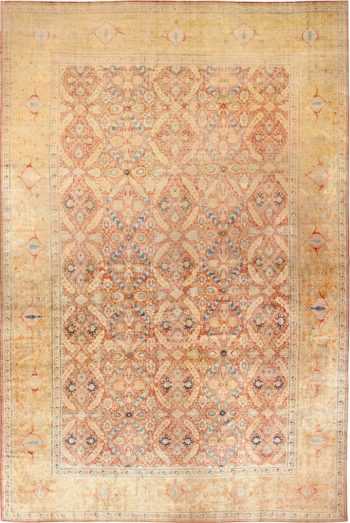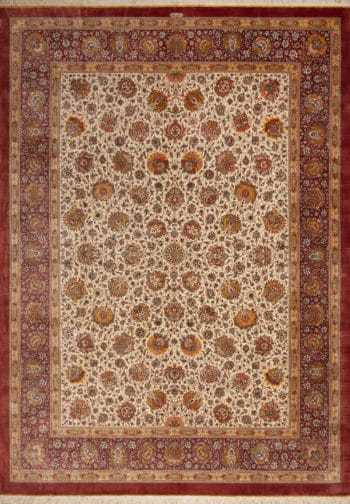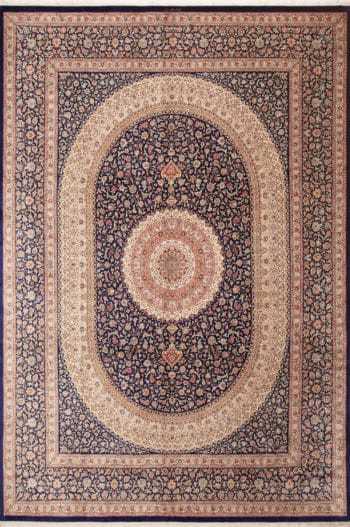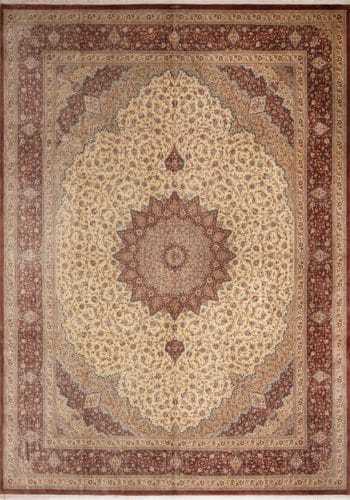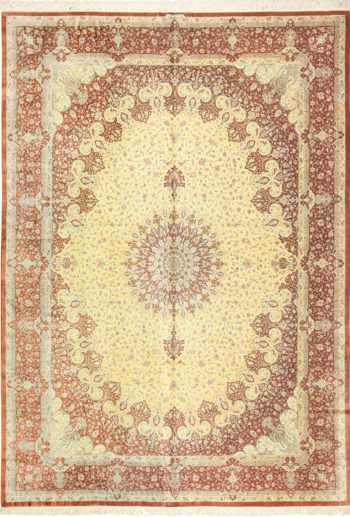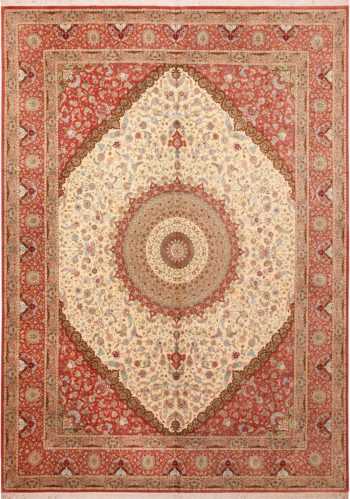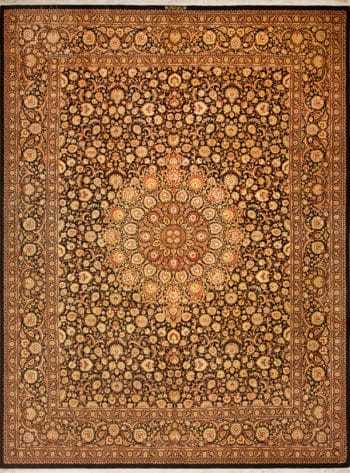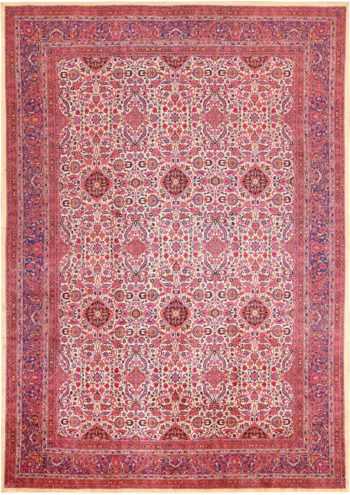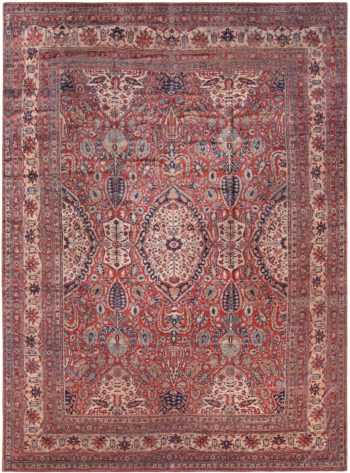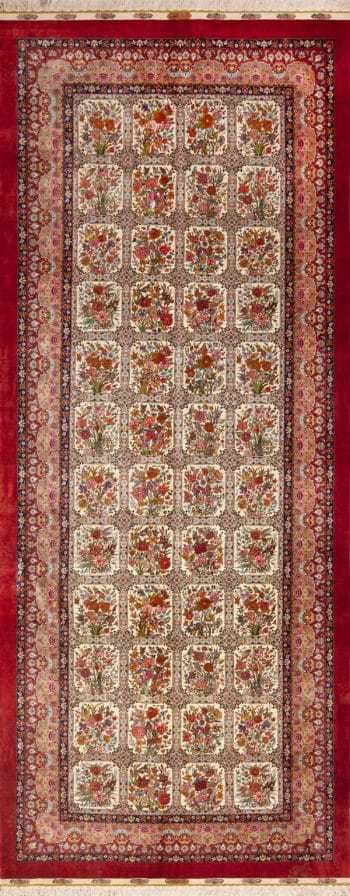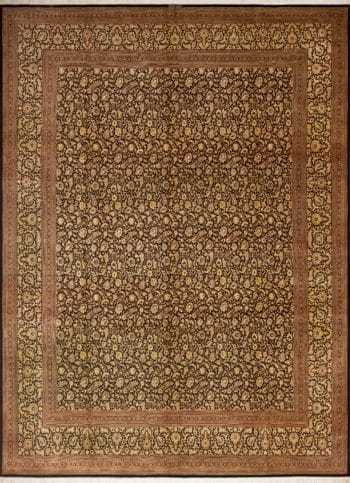Silk Rugs
View our current selection of fine antique and beautiful Silk rugs and carpets below:
-
Large 17th Century Indo-Portuguese Summer Carpet 46159
Size: 13 ft 2 in x 26 ft (4.01 m x 7.92 m) -
Oversized Antique Persian Silk Tabriz Haji Jalili Rug 48981
$320,000.00Size: 15 ft 8 in x 24 ft 6 in (4.78 m x 7.47 m) -
Silk Large Antique Persian Tabriz Rug 71986
$96,000.00Size: 12 ft 2 in x 19 ft (3.71 m x 5.79 m) -
Antique African Silk Loincloth 70849
Size: 1 ft 10 in x 15 ft (0.56 m x 4.57 m) -
Rare Fine High Quality Antique High End Luxurious Persian Silk Haji Jalili Tabriz Area Rug 7991
Size: 10 ft 7 in x 14 ft 5 in (3.23 m x 4.39 m) -
Luxurious Room Size Ivory Allover Floral Design Fine Vintage Silk Persian Qum Rug 72757
$53,550.00Size: 10 ft x 13 ft 9 in (3.05 m x 4.19 m) -
Luxurious Room Size Silk Vintage Blue Persian Fine Qum Gonbad Design Rug 72741
$38,150.00Size: 9 ft 7 in x 13 ft 9 in (2.92 m x 4.19 m) -
Fine Room Size Vintage Persian Luxury Gonbad Design Silk Qum Rug 72759
$45,150.00Size: 10 ft x 13 ft 8 in (3.05 m x 4.17 m) -
Red Fine Floral Luxurious Vintage Persian Qum Silk Hallway Runner Rug 72787
$15,050.00Size: 2 ft 9 in x 13 ft 7 in (0.84 m x 4.14 m) -
Fine Floral Long Narrow Gallery Size Vintage Luxury Persian Silk Qum Rug 72744
$26,250.00Size: 5 ft 2 in x 13 ft 6 in (1.57 m x 4.11 m) -
Fine Luxurious Silk Formal Medallion Room Size Persian Qum Rug 49398
$53,200.00Size: 9 ft 6 in x 13 ft 6 in (2.9 m x 4.11 m) -
Extremely Fine Weave Floral Central Medallion Vintage Room Size Persian Silk Qum Rug 70244
$52,500.00Size: 9 ft 9 in x 13 ft 5 in (2.97 m x 4.09 m) -
Fine Room Size Vintage Persian Silk Qum Rug 70245
$46,900.00Size: 10 ft x 13 ft 4 in (3.05 m x 4.06 m) -
Fine Luxurious Floral Design Vintage Persian Qum Silk Hallway Runner Rug 72792
$15,750.00Size: 2 ft 7 in x 13 ft 3 in (0.79 m x 4.04 m) -
Fine Floral Vintage Persian Gonbad Design Silk Qum Luxury Hallway Runner Rug 72789
$15,050.00Size: 2 ft 8 in x 13 ft (0.81 m x 3.96 m) -
Fine Traditional Vintage Persian Silk Qum Luxury Rug 72758
$30,975.00Size: 9 ft 10 in x 13 ft (3 m x 3.96 m) -
Luxurious Fine Floral Vintage Persian Silk Qum Hallway Runner Rug 72790
$15,750.00Size: 2 ft 8 in x 13 ft (0.81 m x 3.96 m) -
Fine Luxurious Ivory Background Antique Allover Floral Silk Persian Kashan Area Rug 71817
$125,000.00Size: 9 ft x 13 ft (2.74 m x 3.96 m) -
Fine Antique Persian Silk Heriz Carpet 47239
$68,000.00Size: 10 ft x 13 ft (3.05 m x 3.96 m) -
Fine Long Narrow Gallery Size Vintage Garden Design Silk Persian Qum Rug 72743
$26,250.00Size: 5 ft 2 in x 12 ft 10 in (1.57 m x 3.91 m) -
Fine Allover Floral Design Luxurious Room Size Vintage Persian Silk Qum Rug 72742
$31,850.00Size: 9 ft 9 in x 12 ft 10 in (2.97 m x 3.91 m) -
Fine Luxurious Persian Qum Silk Hallway Runner Rug 72786
$15,050.00Size: 2 ft 7 in x 12 ft 9 in (0.79 m x 3.89 m) -
Fine Intricate Floral Vintage Persian Silk Qum Hallway Runner Rug 72754
$18,550.00Size: 3 ft 7 in x 12 ft 9 in (1.09 m x 3.89 m) -
Beautifully Luxurious Fine Antique Persian Silk Heriz Masterpiece Rug 71939
Size: 8 ft 4 in x 12 ft 6 in (2.54 m x 3.81 m)
Learn More About Fine and Antique Silk Rugs
Silk Carpets and area rugs are the most luxurious productions of their kind. The silk textile production began in China, although silk rugs are unattested there until the seventeenth century.
Silk textile manufacture was well established in Persia by the Sassanian Period (third to seventh centuries). Consequently, it would have been possible for the Persians of this period or those of Early Islamic times to have adapted silk to rug production. But it is so far unclear whether China or the Islamic Orient initiated the manufacture of silk carpets.
At any rate, the earliest extant of all the antique handmade silk rugs are in fact the handmade Persian silk rugs of the Safavid Period. Eventually rugs with all or part silk construction came to be made in virtually all Oriental rug – producing regions – Persia, Turkey, Turkestan, Tibet, and China. In the finest examples, not only the pile but even the foundation (wefts and warp fringes) are made of silk. Silk rugs are luxurious not only because of the fine texture and the reflective, luminous properties of the pile, but also because of the quality of their color. Silk allows the dyes to achieve a richness and intensity that can never be matched by even the finest wool.
Silk is a magical fiber that is unbelievably thin and astoundingly strong. Even when silk highlights are used to add definition to ornate designs, the complexion of a carpet or textile can change completely. The hand of silk rugs and textiles is rich and sumptuous. These traits are matched by the luminosity of colors when light is reflected by the fiber’s prismatic structure. Silk is lithe yet exceptionally durable. As a commodity, it built the world’s most famous trade route and created immortal legends. Today, silk is still the ultimate luxury fiber. The intrinsic value and beauty of silk is destined to outshine all other natural and synthetic fibers known to man.
The Unmistakable Look of Antique Silk Rugs
Silk rugs have an unmistakable luminescence, sheen and sumptuous soft texture. This luxurious fiber has a magical effect when used to craft rugs or when used as decorative accents to give designs a shimmering glow. Thinner than a human hair, silk fibers have a crystalline structure that refracts ambient light and produces the sleek shiny look that this natural fiber is known for. Although the process for unwinding thousands of feet of silk from a cocoon is tedious, the stunning result is well worth the labor. These magnificent carpets were produced extensively in India, China, Persia and Turkey. Handmade silk rugs have an incomparable beauty and luxurious appearance that makes them exceptionally desirable. When displayed on the floor or on a wall, silk rugs make an impressive statement.
Are silk rugs hard to care for?
Silk rugs are known for their luxurious appearance and feel, but they do require a bit more care compared to rugs made from more durable materials like wool or synthetic fibers. While silk is a strong and resilient natural fiber, it is also more delicate and sensitive to certain cleaning methods.
Here are some considerations for caring for silk rugs:
- Avoid Direct Sunlight: Exposure to direct sunlight can cause the colors in silk rugs to fade over time. Try to place silk rugs in areas with minimal sunlight or use window coverings to protect them.
- Regular Vacuuming: Vacuum your silk rug regularly to remove dust and dirt. Use a vacuum cleaner with a low-suction setting or a handheld vacuum to prevent any potential damage to the delicate fibers.
- Gentle Cleaning: In case of spills, it’s essential to clean them promptly. Use a clean, damp cloth to blot the spill, and avoid rubbing, as it can damage the silk fibers. For more stubborn stains, consult a professional rug cleaner experienced with silk rugs.
- Professional Cleaning: Silk rugs should be professionally cleaned by experts who specialize in handling delicate materials. Do not attempt to clean a silk rug with harsh chemicals or by machine washing, as this can cause irreparable damage.
- Rotate the Rug: To ensure even wear, rotate the silk rug periodically, especially in high-traffic areas.
- Use a Rug Pad: Place a quality rug pad underneath the silk rug to provide extra cushioning and prevent slipping. This will also help protect the rug from wear and tear.
- Store Properly: If you need to store the silk rug, roll it up rather than folding it to prevent creases. Store it in a cool, dry place to avoid any potential for mold or mildew growth.
- Test Cleaning Products: Before using any cleaning products on a silk rug, test them in an inconspicuous area to ensure they won’t cause damage or discoloration.
Silk rugs can add a touch of elegance to your home, but proper care is essential to maintain their beauty and longevity. Always follow the manufacturer’s care instructions and consider consulting with a professional rug cleaner for guidance on the best practices for cleaning and maintaining your specific silk rug.
Is silk good fiber for a rug?
Silk can be an excellent material for rugs, offering a luxurious and soft feel along with a beautiful sheen.
However, whether silk is a good choice for a rug depends on various factors and considerations:
- Aesthetic Appeal: Silk rugs are known for their rich colors, intricate designs, and lustrous appearance. They can add a touch of luxury and sophistication to any space.
- Softness: Silk fibers are incredibly fine and soft, providing a smooth and comfortable texture underfoot. This can make silk rugs a desirable choice for areas where comfort is a priority.
- Natural Fiber: Silk is a natural fiber with unique properties. It has a natural sheen and can reflect light in a way that synthetic fibers often cannot replicate.
However, there are some considerations and potential drawbacks to using silk for rugs:
- Durability: While silk is a strong natural fiber, it is not as durable as some synthetic fibers or other natural fibers like wool. Silk rugs may be more susceptible to wear and damage, especially in high-traffic areas.
- Cost: Silk rugs are generally more expensive than rugs made from other materials due to the labor-intensive process of harvesting silk and the intricate craftsmanship involved in weaving silk rugs.
- Maintenance: Silk rugs require special care to maintain their appearance and longevity. They are more delicate than rugs made from sturdier materials, and improper cleaning methods can lead to damage.
- Susceptibility to Stains: Silk is more prone to staining than some other rug materials. Spills should be addressed promptly, and professional cleaning may be necessary for tough stains.
- Not Ideal for All Environments: Silk rugs may not be the best choice for high-traffic areas or homes with active children or pets. In such environments, a more durable material like wool or a synthetic blend might be a better option.
Silk rugs can be a fantastic choice for certain environments where aesthetics and a luxurious feel are prioritized, and the rug will be treated with care. However, for areas with high traffic or the potential for spills and stains, more durable rug materials might be preferable. It’s essential to consider your lifestyle, budget, and maintenance preferences when deciding if silk is the right material for your rug.
What’s the Difference between Silk and Faux Silk Rugs?
The main difference between silk and faux silk rugs lies in the materials used to create them.
Silk Rugs:
- Natural Fiber: Silk rugs are made from natural silk fibers obtained from silkworms. The process involves carefully harvesting silk threads from silk cocoons produced by silkworms during their pupal stage.
- Luxurious Feel: Silk is known for its softness, luxurious feel, and natural sheen. Silk rugs often have a distinct luster that adds to their visual appeal.
- Higher Cost: Due to the labor-intensive and intricate process of producing silk, rugs made from genuine silk tend to be more expensive than those made from synthetic materials.
Faux Silk Rugs:
- Synthetic Fiber: Faux silk rugs, on the other hand, are made from synthetic fibers such as viscose or polyester. These fibers are designed to mimic the look and feel of natural silk but are manufactured using man-made materials.
- Affordability: Faux silk rugs are generally more affordable than genuine silk rugs. The synthetic manufacturing process allows for a lower production cost.
- Durability: Faux silk rugs are often more durable and resistant to wear and tear compared to natural silk rugs. They may also be more stain-resistant, making them suitable for areas with higher foot traffic or the potential for spills.
When choosing between silk and faux silk rugs, it’s essential to consider your budget, the intended use of the rug, and your preferences for feel and appearance. While silk rugs offer a luxurious and authentic feel, faux silk rugs provide a more budget-friendly alternative with increased durability. Additionally, faux silk rugs might be a preferable choice in households with active children or pets due to their resistance to stains and wear.
How long does a silk rug last?
The lifespan of a silk rug can vary depending on several factors, including the quality of the silk, the construction of the rug, the level of foot traffic it experiences, and how well it is maintained. Generally speaking, a well-cared-for silk rug can last for many years, and in some cases, even generations.
Here are some considerations that can impact the longevity of a silk rug:
- Quality of Silk: High-quality silk is more durable and resilient. Rugs made from finer silk fibers are often more luxurious and may have a longer lifespan.
- Construction: The way a silk rug is constructed can affect its durability. Hand-knotted silk rugs, where each knot is tied by hand, are typically more durable than machine-made or hand-tufted rugs.
- Foot Traffic: High-traffic areas can contribute to wear and tear on a rug. Placing silk rugs in low-traffic areas or using them as decorative pieces rather than in heavily used spaces can help extend their lifespan.
- Maintenance: Proper care is crucial for preserving the life of a silk rug. Regular vacuuming, prompt cleaning of spills, and professional cleaning when needed can contribute to its longevity.
- Exposure to Sunlight: Prolonged exposure to direct sunlight can fade the colors in a silk rug over time. Placing the rug in a location where it is shielded from excessive sunlight can help preserve its appearance.
- Environmental Conditions: Humidity and temperature fluctuations can affect natural fibers like silk. Maintaining a stable environment, avoiding extremes in temperature and humidity, can help prevent damage.
- Proper Use of Rug Pads: Using a high-quality rug pad can provide extra cushioning, prevent slipping, and protect the rug from abrasion with the floor.
It’s important to note that while silk rugs are known for their beauty and softness, they are more delicate than rugs made from sturdier materials such as wool or synthetic fibers. Careful consideration of the factors mentioned above and adherence to proper maintenance practices will contribute to the long-term preservation of a silk rug.
What happens if a silk rug gets wet?
Silk rugs are more delicate than rugs made from sturdier materials, and exposure to water or moisture can potentially damage them. If a silk rug gets wet, it’s important to take immediate action to prevent lasting harm.
Here are the steps you should follow:
- Blot the Moisture: Use clean, white towels or paper towels to blot the excess moisture from the silk rug. Press down gently to absorb as much water as possible. Do not rub the rug, as rubbing can damage the delicate silk fibers.
- Remove the Rug: If the silk rug is small enough and can be easily moved, take it outdoors to a dry and shaded area. Lay it flat on a clean, dry surface.
- Ventilation and Air Circulation: Allow the silk rug to air-dry naturally. Ensure proper ventilation and air circulation to facilitate the drying process. Avoid direct exposure to sunlight, as it may lead to color fading.
- Use Fans or Dehumidifiers: If possible, use fans or dehumidifiers to speed up the drying process. Make sure the rug is thoroughly dry before placing it back in its original location.
- Professional Cleaning: If the silk rug has been significantly soaked or exposed to dirty water, it may be advisable to seek professional cleaning services. Professional rug cleaners with experience in handling silk rugs can assess the extent of the damage and take appropriate measures to clean and restore the rug.
It’s crucial to act quickly when a silk rug gets wet, as prolonged exposure to moisture can lead to mold or mildew growth, color bleeding, and damage to the structure of the rug. Additionally, avoid using harsh cleaning agents or attempting to machine wash a silk rug, as these actions can cause irreversible damage.
Prevention is key, so it’s essential to keep silk rugs in low-humidity environments, avoid placing them in areas prone to spills or water exposure, and take precautions during cleaning and maintenance to minimize the risk of moisture-related issues.
Can silk rugs be vacuumed?
Yes, silk rugs can be vacuumed, but it’s important to do so with care to avoid causing damage to the delicate fibers.
Here are some tips for vacuuming silk rugs:
- Use a Low Suction Setting: Silk fibers are fine and can be more delicate than other rug materials. To prevent pulling or damaging the fibers, use a vacuum cleaner with an adjustable suction setting, and set it to a low or medium level.
- Turn Off Beater Bars: Many vacuum cleaners have beater bars or rotating brushes designed for deep cleaning carpets. However, these can be too aggressive for silk rugs. If your vacuum cleaner has a beater bar, turn it off or use an attachment without the rotating brush.
- Use a Handheld Vacuum: If you have a handheld vacuum with a gentle suction, it can be an excellent option for cleaning silk rugs. It provides more control and reduces the risk of damage.
- Frequency of Vacuuming: Vacuum your silk rug regularly to remove dust, dirt, and debris. However, if the rug is in a low-traffic area, less frequent vacuuming may be sufficient.
- Rotate the Rug: To ensure even wear, rotate the silk rug periodically. This helps distribute foot traffic and sunlight exposure more evenly across the rug.
- Avoid Fringe: Be cautious around the fringe of the silk rug, as it is often more delicate. Vacuum the fringe carefully, and consider using an attachment with a softer brush or a handheld vacuum for this area.
- Inspect the Vacuum Cleaner: Before vacuuming, ensure that the vacuum cleaner is clean and free of debris. A dirty vacuum can scratch or damage the rug.
Always check the manufacturer’s care instructions for your specific silk rug, as there may be additional recommendations or precautions. If you are uncertain about vacuuming your silk rug or if it has specific cleaning instructions, consider consulting with a professional rug cleaner who specializes in delicate materials like silk. Regular and gentle vacuuming, combined with proper care, can help maintain the beauty and longevity of your silk rug.
How can you tell if a rug is real silk?
Burn Test: This is a more invasive method and should be used with caution. Take a small, inconspicuous fiber from the rug and burn it with a flame. Genuine silk fibers will burn slowly and smell like burning hair, while synthetic fibers may burn more quickly and produce a different odor.
Why do silk rugs tend to be more expensive?
Silk rugs are often more expensive than rugs made from other materials due to several factors that contribute to the cost of producing and obtaining silk.
Here are some reasons why silk rugs tend to be pricier:
- Labor-Intensive Production: The production of silk involves a labor-intensive and time-consuming process. Silkworms are cultivated, and their cocoons are carefully harvested. Each cocoon yields a limited amount of silk thread, and the delicate nature of the fiber requires meticulous handling.
- Limited Silk Production: The amount of silk that can be obtained from each silkworm cocoon is relatively small. This limited supply of silk contributes to its higher cost compared to more abundant rug materials.
- Artisanal Craftsmanship: Silk rugs are often crafted using traditional weaving techniques that require skilled artisans. The intricate patterns and designs found in silk rugs may involve meticulous hand-knotting, adding to the labor and expertise involved in their creation.
- Luxurious Appearance: Silk has a natural sheen and luster that gives rugs a luxurious appearance. This visual quality, along with the soft and smooth feel of silk, enhances the overall aesthetic appeal of silk rugs, making them desirable for those seeking a touch of luxury in their home decor.
- Fine and Delicate Fibers: Silk fibers are extremely fine and delicate, requiring careful handling during the weaving process. This delicacy increases the risk of breakage and demands a higher level of craftsmanship.
- Natural Material: Silk is a natural fiber, and its production is influenced by environmental factors. Natural variations in the silk contribute to the uniqueness of each rug, but they can also impact the consistency and availability of the material.
- Low Resistance to Stains: Silk is more susceptible to stains than some other rug materials, requiring additional care and caution during the manufacturing process to minimize the risk of imperfections.
- Limited Size of Silk Farms: Silk production is concentrated in certain regions and is limited by factors such as climate and the availability of mulberry trees, which are crucial for silkworms’ diet. The restricted number of silk farms contributes to the scarcity of the material.
The combination of a labor-intensive production process, limited silk production, artisanal craftsmanship, the luxurious appearance of silk, and its delicate nature all contribute to the higher cost of silk rugs compared to rugs made from more readily available and durable materials.
Can you walk on silk rugs?
In short – yes, you can walk on silk rugs. That said, while silk rugs are known for their luxurious appearance and soft feel, they are more delicate than rugs made from sturdier materials like wool or synthetic fibers.
While it is possible to walk on silk rugs, there are some considerations to keep in mind to preserve their beauty and longevity:
- Low-Traffic Areas: Silk rugs are best suited for low-traffic areas where there is minimal foot activity. Placing them in spaces where people don’t walk as frequently, such as formal living rooms or bedrooms, can help minimize wear and tear.
- Use Rugs Pads: Placing a high-quality rug pad underneath the silk rug can provide extra cushioning, prevent slipping, and protect the rug from abrasion with the floor. This helps distribute the weight of foot traffic more evenly.
- Remove Shoes: Encourage people to remove their shoes before walking on the silk rug. Shoes can carry dirt, debris, and moisture that may be harmful to the delicate fibers.
- Rotate the Rug: Periodically rotate the silk rug to ensure even wear. This helps distribute any foot traffic or furniture weight more uniformly across the rug.
- Avoid Spills: Silk rugs are more prone to staining than rugs made from other materials. Avoid placing them in areas where spills are likely, and address any spills promptly by blotting them with a clean, dry cloth.
- Professional Cleaning: Silk rugs require special care when it comes to cleaning. If the rug becomes soiled, it’s advisable to seek professional rug cleaning services experienced in handling delicate materials like silk.
Many silk rugs, especially the area antique examples in good condition, are an investment, and their delicate nature requires careful consideration of where and how they are used. While they can be walked on, taking precautions to minimize wear, avoiding high-traffic areas, and providing proper care will contribute to maintaining the silk rug’s beauty over time.
Are silk rugs shiny?
Yes, silk rugs are known for their natural sheen and luster. The inherent characteristics of silk fibers contribute to the shiny appearance of silk rugs. Silk has a smooth and reflective surface that allows it to capture and reflect light, creating a beautiful sheen.
The natural sheen of silk is one of the reasons why silk rugs are highly valued for their aesthetic appeal. The interplay of light on the silk fibers adds a luxurious and elegant quality to the rug. This sheen enhances the richness of colors and intricate patterns, making silk rugs a popular choice for those seeking a touch of sophistication and luxury in their home decor.
It’s important to note that the level of shine can vary depending on factors such as the quality of the silk, the weaving technique, and the rug’s overall design. Additionally, the shiny appearance of silk may be more pronounced in certain lighting conditions. Over time, with proper care, the natural sheen of silk can contribute to the enduring beauty of silk rugs.
What were the main cities that are famous for weaving some of the best silk rugs?
Several cities around the world have a long-standing tradition of producing some of the finest silk rugs, known for their intricate designs and exceptional craftsmanship. These cities are renowned for their rich textile history and the skill of their weavers.
Some of the main cities famous for weaving high-quality silk rugs include:
- Kashan (Iran): Kashan has a long history of rug weaving, and silk rugs from this city are highly regarded for their exquisite designs and fine craftsmanship. Kashan silk rugs often feature intricate floral motifs, medallions, and vibrant colors.
- Isfahan (Iran): Isfahan is another Iranian city known for its silk rug production. Isfahan silk rugs are prized for their high knot density, detailed patterns, and rich color palettes. The designs often include floral motifs and intricate curvilinear patterns.
- Qum (Iran): Qum, also spelled Qom or Ghom, is famous for its silk rugs that are characterized by intricate designs, high knot density, and a wide range of colors. Qum silk rugs often feature detailed medallions, floral motifs, and religious or pictorial elements.
- Hereke (Turkey): Hereke, located near Istanbul, Turkey, is renowned for its fine silk and wool rugs. Hereke silk rugs are known for their exceptional craftsmanship, intricate designs, and the use of silk threads that add a luxurious sheen.
- Bursa (Turkey): Bursa is another Turkish city with a strong tradition of rug weaving. While Bursa produces both wool and silk rugs, its silk rugs are highly esteemed for their quality and artistic designs.
- Varanasi (India): Varanasi, also known as Banaras, is a city in India famous for its silk weaving industry. While it is renowned for silk fabrics, Varanasi also produces silk rugs featuring intricate patterns, often inspired by traditional Indian motifs.
- Hangzhou (China): Hangzhou is known for its historic silk production, and it is recognized for weaving silk rugs with traditional Chinese designs. Chinese silk rugs often feature intricate patterns, floral motifs, and auspicious symbols.
- Kayseri (Turkey): Kayseri is a Turkish city that produces a variety of carpets, including silk rugs. Kayseri silk rugs are known for their quality craftsmanship, intricate patterns, and use of silk to enhance the overall appearance.
These cities have played a significant role in the history of silk rug weaving, and their products continue to be highly sought after by collectors and enthusiasts worldwide. Each region has its unique style and design motifs, reflecting the cultural and artistic influences of the area.
Cultivating, Curating, Producing and Harvesting Silk For Weaving Silk Rugs
Producing Silk
When creating silk rugs, most commercial silk is harvested from the Bombyx mori, which is also known as the mulberry silk moth, or more colloquially as the silkworm. The silk, an animal protein fiber, is produced by the moth when it is in its larval or caterpillar stage. It is not literally a worm, but bears some resemblance to a worm at this stage of its life cycle.
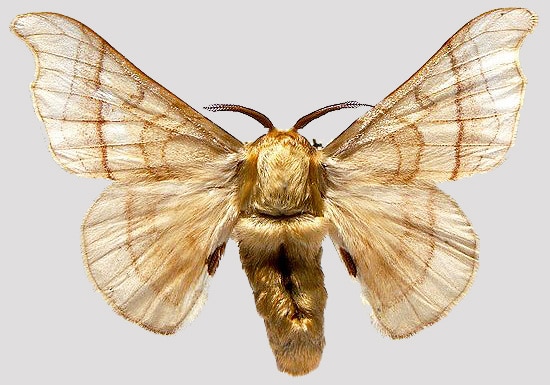
The Mulberry Silk Moth
Silk for silk rugs have been produced by domesticated species for thousands of years. The Bombyx mori was domesticated from the wild Bombyx mandarina, and eventually came to differ substantially from it. The Bombyx mori has lost its pigmentation and its ability to fly, and is largely dependent on humans for its reproduction.
Life Cycle of the Silkworm
Cultivation of silk from domestic silkworms is called “sericulture.”
The first stage of the silkworm life cycle, and hence the first stage of the sericulture process, is the laying of eggs. This is typically done in an aluminum box or other container. Each egg is as tiny as a pinhead. An adult female silkworm (that is, one that is in the moth stage of its life cycle) typically lays 300-400 eggs at a time. It dies almost immediately upon laying its eggs, and the adult males die shortly thereafter. In fact, the adult stage of the life cycle is very brief; the adults possess only a rudimentary mouth and do not even eat.
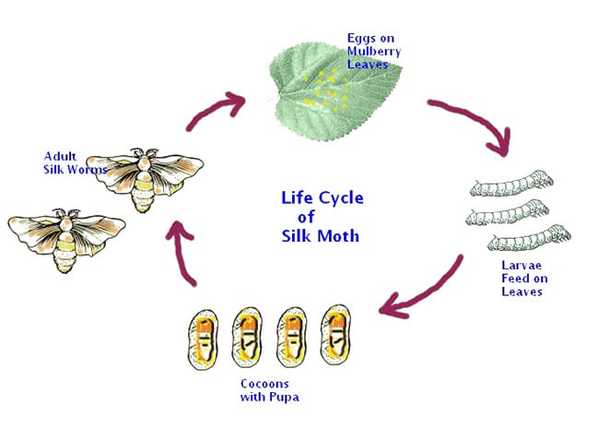
The Life Cycle Of A Silk Worm
The eggs are examined carefully for any sign of disease. If no such problems are detected, they are incubated for about ten days.
When the eggs hatch, this commences the larva stage. The caterpillars are only about a quarter inch long when they emerge from the egg, but they grow rapidly to a size of about three inches as they do little more than eat constantly during this stage. The caterpillar will ultimately eat about 50,000 times its initial weight.
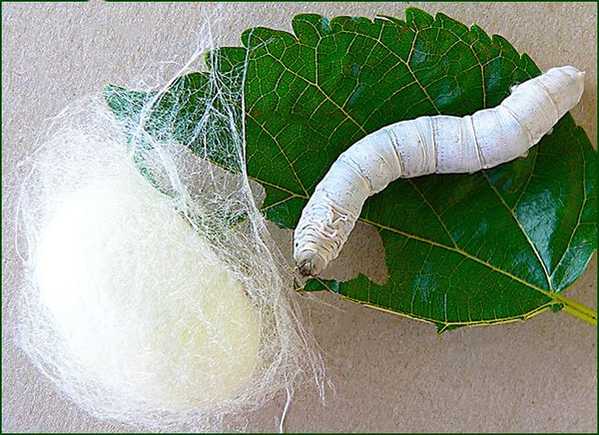
The Mulberry Silk Moth Caterpillar Stage
A fine layer of gauze is placed over the caterpillars when the eggs hatch. They are fed primarily chopped white mulberry leaves, hence the alternate name of mulberry silk moth. Lettuce, Osage orange, and other plant material is also sometimes used as feed. The caterpillars eat and grow for about six weeks, shedding their skin four times along the way.
At this point, the caterpillars are ready to spin their cocoons, which takes three to eight days. This is when the silk is produced.

The Mulberry Silk Moth Caterpillar Building Its Cocoon
The silkworm climbs up onto some sort of frame that has been provided for that purpose in its container. A pair of salivary glands in the silkworm called “sericteries” produce a clear, viscous fluid called “fibroin,” while another pair of glands produce a gummy fluid called “sericin.” The silkworm forces these substances through openings—spinnerets—in its mouthpart. The fibroin secretions harden immediately when exposed to the air, forming twin filaments. These filaments are then immediately bonded together by the sericin.
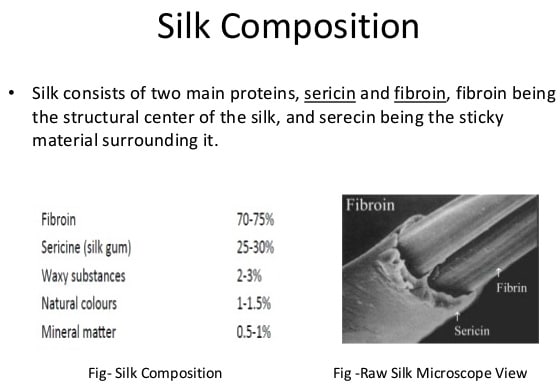
Sericin and The Chemical Composition Of Silk
This is the silk of the silkworm.
For the next several days, the silkworm meticulously builds its cocoon with this silk, following a figure-8 path hundreds of thousands of times. Over the course of this time it produces approximately one kilometer of silk.
Harvesting the Silk For Weaving Silk Rugs
At this point, the cocoon is carefully heated to loosen the silk. The silk is softened, and then gradually unwound. Generally the silk of four to eight cocoons is unwound together, forming one thicker strand.
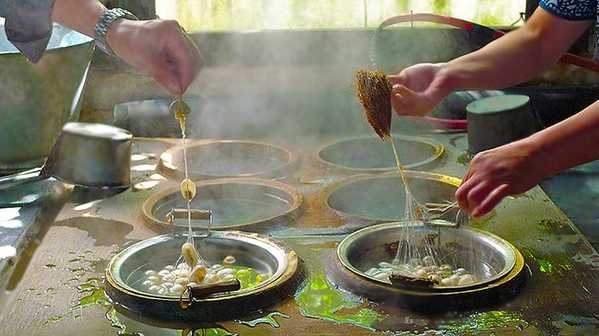
Harvesting and Unwinding Silk
Through a process called “throwing,” the raw silk is then twisted into a strand strong enough not to split into its constituent fibers. This renders it suitable for knitting or weaving.

A Simple Silk Throwing Frame
There are four different common types of silk thread produced this way, each by a slightly different method of throwing. Crepe is produced by twisting multiple threads together, and then twisting them a second time. Tram is produced similarly, but the silk threads are only twisted in one direction instead of two. Thrown singles are produced with just one thread rather than multiple. Like tram they are only twisted in one direction. Finally, organzine is produced by giving individual silk threads a twist before combining two of them and twisting them in the opposite direction.
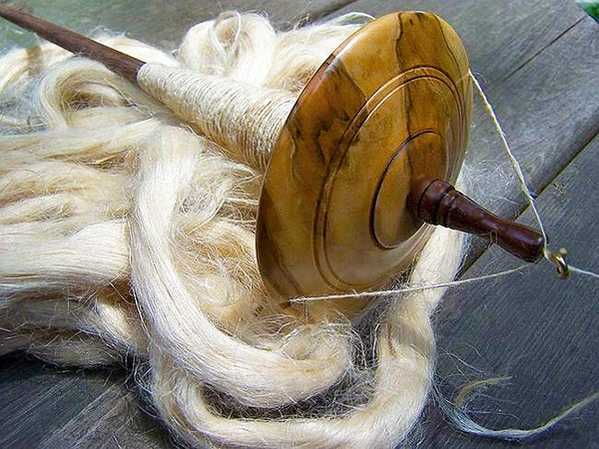
Spinning Silk Into Thread
Crepe thread is used for weaving wrinkly fabrics, tram thread is used for the weft part of the weaving process, thrown singles thread is used for sheer fabrics, and organzine thread is used for the warp part of the weaving process.
Raw silk still contains the binding agent sericin. Soap and boiling water are then used to remove this sericin. This leaves the silk as much as 30% lighter than the raw silk, as well as softer and more lustrous.
Though a kilometer of silk from each cocoon sounds like a great deal, in fact very little survives this process as usable silk. It typically takes about 2,500 silkworms to produce one pound of raw silk.
Filaments that cannot be used as silk can be salvaged and processed into a cheaper type of yarn called “spun silk.”
Alternatives to Silkworms For Cultivating Silk
Many other animal species produce silk. Silk is produced by many species of bees, wasps and ants, often for nest construction. Most famously, spiders and other arachnids use silk to spin their webs.
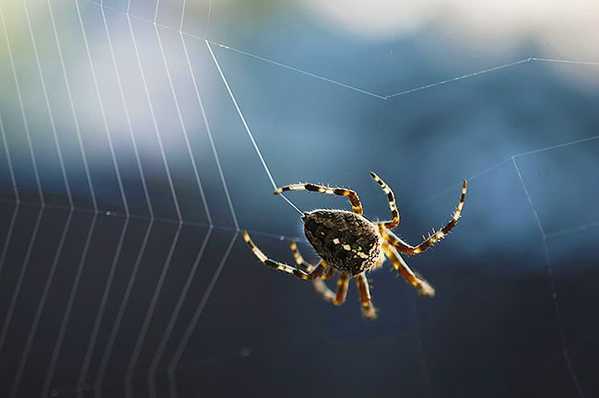
Spider Weaving His Silk Web
None of these other species have been used for commercial textile production, though research continues into whether any such alternative to the silkworm might be viable. Already the silk from some of these other animals has been used in weapons and optical instruments such as telescopes.
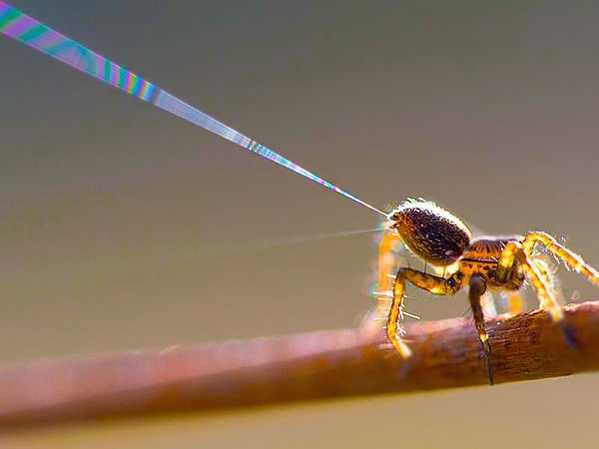
Spider Silk
Weaving Silk Rugs
As noted above, silk is an animal fiber that is derived from the cocoons of silkworms. It is an extremely costly and luxurious material for textile and rug production. Cultivation of these fibers began in ancient China where it was a jealously guarded secret. Eventually its use spread to Persia and then to Byzantium and Europe.
The expense notwithstanding, silk rugs and or foundations, are not uncommon, although they tend to be high quality pieces in the tradition of court art.

Silkworm Cocoons
Extremely luxurious nomadic carpet weaving have been known to use the fibers as a sign of class and significance. The attraction to these rugs resides in the fineness of its fibers which are remarkably soft, as well as in it’s luminous, reflective quality.
Because of this the effect of color on silk is far more intense and brilliant than the effect of the same dye on even the finest wool. These fibers when treated (see below) are much more delicate and less durable than wool.
Consequently, many less silk rugs are well preserved. This rarity, as well as the basic cost, places antique silk pieces among the most expensive rugs.
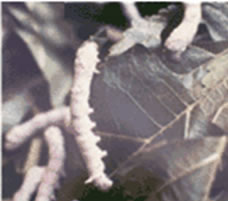
Silkworms
These fibers were bought and sold by their weight. As such, some traders would treat the fibers with metal. This metal treatment, increased the overall weight which resulted in more money for the dealer.
Unfortunately, the metal corrodes with time. This is what causes some antique carpets to “break”. So when buying these types of antique rugs, it is important that the piece be in excellent starting off condition – that is a great sign that the fibers have not been treated and should last for many generations to come.
To learn more about the rug weaving process, visit How Rugs & Carpets are Made


